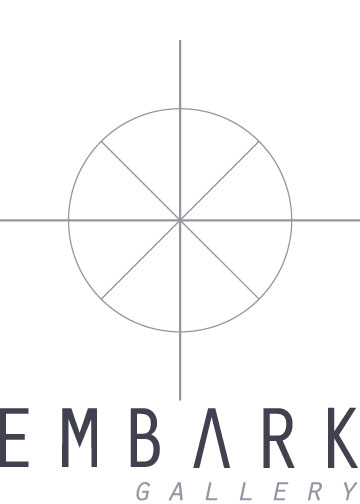A critical essay by artist Xiao Wang
Out of the Loop: This Is Not a Painting Artists Innovate at Embark Gallery
Pushing the idea of abstract painting forward in the context of postmodernism hasn’t been easy. For some leading contemporary institutions, the act of painting has become somewhat of a formula. Painters find themselves re-living the glorious moments of their ancestors: minimalism, abstract expressionism, cubism, and so on—abstract painting has become the autobiography of itself. This leaves the possibility for a future that is, optimistically, rich in reference yet also paralyzing. In The New Yorker’s review of the recent painting show Forever Now at MoMA, curator Laura Hoptman’s idea was explained: “All eras seem to exist at once," thus freeing artists, yet also leaving them no other choice but to adopt or, at best, reanimate familiar "styles, subjects, motifs, materials, strategies, and ideas."[1] Innovation has always been the central topic of any progressive art, but when we find the very word “innovation” has lost its meaning and purpose, maybe it’s time to look for a new objective.
This Is Not a Painting at Embark Gallery provides a different perspective on the age-old argument on what painting is, or has become. The exhibition features 8 Bay Area women artists that are either current MFA student or recent MFA graduates. Don’t come to the show expecting to see some pretentiously large canvases, in fact, none of the artists—except for one—can be identified as painter in an explicit sense. The statement here is clear, instead of looking for new path within the painting realm, they ask a question: how can other mediums engage with painting?
We are all too familiar with the frustration of getting into a “medium war” in a typical graduate seminar, and the last thing we want to debate in a critique group is whether something is a painting or a sculpture. The title of the show plays a trick by stating the theme of the show without getting into the meaningless argument, so we can move on and focus on the content of the work. Overall, the works are reasonably small and distanced, giving the presentation a clean quality without making it seem underwhelming, I find myself constantly pushing and pulling between each artist’s work. One artist that first struck my eyes was Marcela Pardo A. Her photograph series consists of three square-shaped portraits, each explores a monochromic theme based on the three primary colors. Pardo plays with this topic by categorizing everyday object by their colors and construct them formally in the backgrounds of the portraits, the lower-centered figures are compositionally surrounded by painted frames. These pictures wittily connect Portraiture, Cubism and Minimalism while seemingly mocking all of them.
One thing worth noting is that all 8 artists selected for this exhibition are coincidentally women—a rare case even for famously progressive Bay Area art scene. This has added a strong feminist element to the show. The resulting genderization of the show breaks away from the linear and male-dominated narrative of painting history.
Perhaps the most politically charged piece is Angela Willetts’s Reclining Nude #2, a video installation that documents her performative painting using both a still camera and a GoPro. In the piece Willetts traces herself using both brush and her body on a couch and a plastic screen. The performance is given a sense of violence by the use of red paint, the violence is also enhanced by the presence the couch that was used in the performance. It is not difficult to read the influence of Janine Antoni’s work in Willetts’ piece, yet she pushed her work further by referencing and protesting the history of figurative painting by positioning herself nude in a gesture that was heavily used to portray the idealized female body.
With a more romantic approach, Miranda Robbins’s mixed media pieces engage with the elements of performative painting in a very different way. She creates her work using complex processes and techniques such as pouring, mixing, even playing sound in order to create texture. The results are stunning sheets of latex that have preserved and transformed found materials into physical memorials. Visually, Robins’ work plays with the push and pull between details of the surface and the fluid formal quality. Conceptually, she connects the elements of sound, material and location. The “body” of the performer in her work is not the maker, but the material itself, as a remnant of a specific place and time.
In “This Is Not a Painting”, abstract painting is no longer considered as a self-referencing medium, in fact, the very fundamental question of what it is has been replaced by what has come out of it. It represents a source of ideology or philosophy that inspire all mediums. The show is therefore by no means attempting to define a direction for contemporary painting, but to find a new way to make use of what we have learned.
[1]Peter Schjeldahl, Take Your Time-New painting at the Museum of Modern Art. The New Yorker, 2015. (http://www.newyorker.com/magazine/2015/01/05/take-time)
By Xiao Wang
